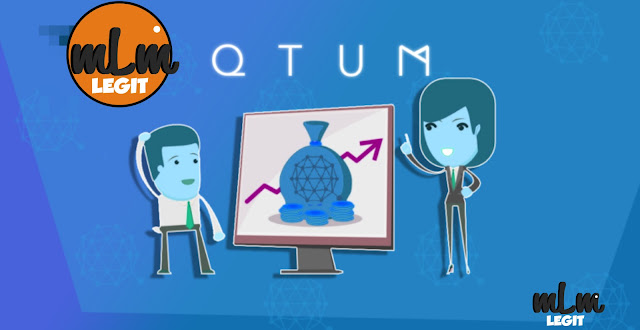Qtum is a 2016 blockchain platform. It has successfully combined Ether’s smart contract functionality with the Bitcoin network’s UTXO .jpg) With the advent of decentralization and the advancement of blockchain technology, various cryptocurrencies began to emerge. With a plethora of possibilities, financial institutions began to acquire whatever they felt fit or which cryptocurrencies corresponded most closely with their business objectives. Today, there are a plethora of cryptocurrencies available, each with a unique consensus process and a distinct function. Some remain loyal to the ethos of a financial company; others assist with scalability and interoperability; and yet others focus exclusively on governance. There are other possibilities, but today we will focus on the Qtum (QTUM). Qtum is a blockchain platform that was launched in 2016. It has done an excellent job of merging the smart contract features of Ether with the Bitcoin network’s UTXO accounting system. Qtum can accomplish this fantastic convergence of both networks through the use of the account abstraction layer; using this incredible technology, Qtum is able to push updates to its primary network directly from Bitcoin and Ether. The entire system is decentralized, which means you do not need authorization to validate transactions, perform transactions, or join the network as a node. Anyone with internet access is able to do so. The process of rewarding validators or miners across the network is also revitalized, as Qtum employs a mutualized proof of stake consensus algorithm, which enables multiple miners to participate in the validation of a single transaction, while the reward is then split into multiple parts and distributed evenly among these miners. The network now supports a variety of different sorts of tokens that originate from a variety of different sources and employ a variety of different cryptographic techniques. The QTUM token, which is the network’s native cryptocurrency, can be used for transaction validation, staking the token in an online or offline array, or trading it on a cryptocurrency exchange of your choice. There is a great deal that can be accomplished over the Qtum network; additional information is provided below.
With the advent of decentralization and the advancement of blockchain technology, various cryptocurrencies began to emerge. With a plethora of possibilities, financial institutions began to acquire whatever they felt fit or which cryptocurrencies corresponded most closely with their business objectives. Today, there are a plethora of cryptocurrencies available, each with a unique consensus process and a distinct function. Some remain loyal to the ethos of a financial company; others assist with scalability and interoperability; and yet others focus exclusively on governance. There are other possibilities, but today we will focus on the Qtum (QTUM). Qtum is a blockchain platform that was launched in 2016. It has done an excellent job of merging the smart contract features of Ether with the Bitcoin network’s UTXO accounting system. Qtum can accomplish this fantastic convergence of both networks through the use of the account abstraction layer; using this incredible technology, Qtum is able to push updates to its primary network directly from Bitcoin and Ether. The entire system is decentralized, which means you do not need authorization to validate transactions, perform transactions, or join the network as a node. Anyone with internet access is able to do so. The process of rewarding validators or miners across the network is also revitalized, as Qtum employs a mutualized proof of stake consensus algorithm, which enables multiple miners to participate in the validation of a single transaction, while the reward is then split into multiple parts and distributed evenly among these miners. The network now supports a variety of different sorts of tokens that originate from a variety of different sources and employ a variety of different cryptographic techniques. The QTUM token, which is the network’s native cryptocurrency, can be used for transaction validation, staking the token in an online or offline array, or trading it on a cryptocurrency exchange of your choice. There is a great deal that can be accomplished over the Qtum network; additional information is provided below.
What exactly is Qtum?
Qtum is a decentralized organization with a single goal in mind: to integrate components of both Ether and Bitcoin using a proprietary system developed by the platform. The unspent transaction output concept was derived from Bitcoin and eventually coupled with Ether’s smart contract paradigm, enabling Qtum to exploit all of the wonderful features associated with these two diametrically opposed decentralized organizations.
Qtum’s operation.
Now that you’ve learned about how Qtum leverages both Bitcoin and Ether technology, you’re probably wondering how it works and what it has to offer. To simplify matters, here are the four dynamic components of the Qtum network:
- The introduction of the UTXO model for accounting purposes
- A solidity-based framework for smart contracts
- A layer of abstraction for accounts
- Demonstration of a stake consensus method capable of tying the entire transaction together
Qtum is using a customized version of the bitcoin core client software to complete or build the network’s transaction base. This network has also been granted the authority to interact with Ether, and as such is required to be EVM compliant or compatible with the Ether enterprise as an Ether virtual machine. The entire firm now employs Solidity as the primary programming languages to simplify and streamline processes, since if a common coding language were used for such an important procedure, things would have been less original and gave the impression of being stuffed. You have complete control over importing any type of code, as well as the Ether smart contract capabilities, directly into Qtum. The proof of stake consensus technique serves as the cherry on top for the entire organization, as it ensures the seamless and rapid resolution of all network-related security issues.
What exactly are UTXOs?
Unspent transaction outputs, or UTXOs, are a very frequent yet unique idea in the world of decentralization; without them, the concept of decentralized transactions would have been impossible. The outputs and inputs are the originating elements for any transaction that is initiated on any network. To illustrate, if you wish to transmit some BTC to a friend or another interested person, you would utilize the UTXO as an input but then transfer the entire transaction to the output just before you are ready to click the send button. When the transaction is submitted or completed on your end, the UTXOs that were used are marked as totally spent. Now, your output will be converted to or transferred to a new UTXO. You may struggle to appreciate the creativity of this method at first, and it may appear simply strange, but at its core, this system does have its own merits. Several of these advantages include the following:
|
On the other hand, Ether employs the same mechanism as a traditional financial institution in order to keep track of the balances of many users and all accounts on the network. This is also a measure taken to ensure that malicious activity on the network can be managed and that the people’s hard-earned money or tokens are not only secure, but that their data/information is updated in real-time to avoid any inaccuracies.
Layer of Account Abstraction
The blockchains that support smart contracts typically do not integrate well with the UTXO accounting system, owing to the fact that they have their own dedicated technology running in the background to take care of things. Another factor is technological problems and a lack of interoperability when it comes to transferring data or smart contracts between the various blockchain platforms available. That is why Qtum has proposed an account abstraction layer as a possible solution to this issue. This enables the account system of Ether to be abstracted from the technological implementations required for it to function correctly and without faults.
READ MORE: OANDA Review: Is OANDA Fraud or Secured?
Is Definite Area Scam? Reasons and Rating
Coins Capital Review – Is Coins Capital Fraud or Secured?
In this case, smart contracts are not identified by their hash remodeling on the blockchain, but rather by their blockchain address or the end balance they contain. However, in order for a smart contract to execute correctly with a UTXO, it must first choose which UTXO to pair with, which must occur throughout the entirety of both public and private addresses via the blockchain functionality. When we consider the internal transactions that occur between these contracts, a similar issue arises. When combined with such smart contracts, the UTXO blockchain is tasked with the responsibility of sourcing all the data existing on the blockchain media for the transactions that are taking place, but this significantly complicates the process rather than simplifying it. This is a nice example of how the account abstraction layer is put to use. It works by recording the result of the UTXO transaction and then creating a smart contract around it; the contract itself contains all the essential information about the transaction, including which UTXO protocol was used and any other information necessary for its timely execution. After developing this smart contract, the AAL (account abstraction layer) will send the transaction to the contract account in order to trigger the execution of this contract. The AAL then fine-tunes the result to conform to the UTXO standard. It’s a lengthy procedure, but it’s not only worth it; it also saves engineers a lot of headaches when it comes to validating transactions and maintaining the network’s integrity. Qtum’s operation and performance are entirely dependent on the AAL technology. It enables the technology to solemnly benefit from Bitcoin and Ether changes. This means that whenever any cryptocurrency receives a new version, Qtum automatically updates itself and gains early access to these improvements. When Ether was finally granted the ability to orchestrate and develop smart contracts, Qtum was able to immediately adopt this change. With several upgrades being made available for Bitcoin and other leading cryptocurrencies, Qtum will be able to not only adopt and intercept all of these updates, but will also be able to utilise whatever specific capabilities these updates include on its own unique network from the start. Qtum is now profiting not just from the lightning network, but also from other similar technologies that exist on Ether, Bitcoin, or both.
The Qtum Consensus Mechanism (QTUM).
There are two types of proof of stake consensus mechanisms. The first is the traditional proof of stake consensus method, and the second is the mutualized proof of stake consensus mechanism. Proof of stake consensus works by allowing numerous validators to participate in the validation of the transaction, but they must stake a proportionate share of tokens to become genuine validators inside the network; otherwise, they will be unable to do so. Mutualized proof of stake consensus is primarily a Qtum technology invention, serving as the custom consensus mechanism. The goal of this unique sort of consensus mechanism was to combat hacker-initiated junk contract spam attacks with the intent of boosting the final cost of the token. This approach enables for the distribution of the block reward across the nodes assigned to transaction validation, but at the expense of significantly delaying payouts. Each reward to be issued is divided into equal portions and then distributed to the successful validator of the current transaction, all the way back to the other nine validators who have been cooperating in a linear chain structure.
As you can see, the other nine validators who submitted their blocks previously are not rewarded, delaying the payouts arranged by the consensus mechanism in question. A portion of the payout is then deferred for the remaining 500 blocks. This method is in place to confuse attackers to the point of insanity, since they will be unable to calculate the additional rewards awarded to validators. Because this is the type of information they should have if they intend to launch a successful network attack. While the other consensus algorithms serving various cryptocurrencies are performing admirably, the added layer of security provided by the mutualized proof of stake consensus algorithm is something else entirely; it is significantly more efficient and secure while remaining interoperable with the numerous ecosystems and crypto networks out there.
Offline Staking with Qtum
You may have heard of the phrase staking; it refers to the process of staking some of the crypto tokens representing a particular blockchain system for an extended period of time in exchange for prizes and other forms of compensation for the time period during which these tokens were staked. This is essentially how staking works now, but offline staking is a brand-new concept introduced by Qtum technology. This is a new mechanism system developed by Qtum for users who possess certain QTUM tokens and wish to profit handsomely from them. Instead of providing custody of your QTUM tokens and staking them to get incentives and other benefits from the network, you are urged to give away simply the wallet address where these QTUM tokens live. This manner, the tokens will remain in your wallet and can be used at any time; this is rather convenient given that you won’t have to deal with the idea of giving away complete custody of your QTUM tokens and thus being prevented from utilizing them until the staking period expires. According to their functions, the mechanism can be separated into two sectors: super stakers and validators. Thus, those who have the tokens in their wallets can submit a delegation request to the super stakers. These are the individuals that will be staking these tokens on behalf of the delegators, and when a transaction is successfully confirmed, they will be required to divide the block reward with their respective delegator. The process is not only simplified but also significantly more efficient this way, but in order for the delegator to receive prospects from the reward, they will also be charged a fee by the super stakers, as these are the individuals who are actually performing all of the heavy lifting for the delegators. After establishing a relationship with a super staker, you would continue to earn QTUM tokens passively. You will not be required to enroll in a smart contract or any other type of decentralized contract because you will not be handing away your tokens but rather the address of the wallet in which they are stored. If you believe it is appropriate, you can withdraw your tokens from your online wallet and store them in a hardware wallet, granting the super staker access to only the address of your online wallet. This way, you won’t have to worry about giving away your tokens or being bound by any arrangement. The Qtum technologies and blockchain system are truly a worthy potential for the crypto world’s next generation, as the solutions proposed by the crypto firm are not only appealing, but also eccentrically charming. check out: https://twistok.com/read-blog/7195_bitcoin-btc-some-indications-that-point-to-the-possibility-of-recovery.html











 Bitcoin
Bitcoin  Ethereum
Ethereum  Tether
Tether  XRP
XRP  Solana
Solana  Dogecoin
Dogecoin  USDC
USDC  Cardano
Cardano  Lido Staked Ether
Lido Staked Ether  TRON
TRON  Avalanche
Avalanche  Chainlink
Chainlink  Wrapped stETH
Wrapped stETH  Toncoin
Toncoin  Sui
Sui  Shiba Inu
Shiba Inu  Wrapped Bitcoin
Wrapped Bitcoin  Stellar
Stellar  Polkadot
Polkadot  Hyperliquid
Hyperliquid  Hedera
Hedera  WETH
WETH  Bitcoin Cash
Bitcoin Cash  LEO Token
LEO Token  Uniswap
Uniswap  Pepe
Pepe  Litecoin
Litecoin  Wrapped eETH
Wrapped eETH  NEAR Protocol
NEAR Protocol  Ethena USDe
Ethena USDe  Aptos
Aptos  USDS
USDS  Internet Computer
Internet Computer  Aave
Aave  Cronos
Cronos  POL (ex-MATIC)
POL (ex-MATIC)  Ethereum Classic
Ethereum Classic  Mantle
Mantle  Render
Render  MANTRA
MANTRA  Monero
Monero  Bittensor
Bittensor  WhiteBIT Coin
WhiteBIT Coin  Artificial Superintelligence Alliance
Artificial Superintelligence Alliance  Dai
Dai  Ethena
Ethena  Arbitrum
Arbitrum 
Leave a Reply